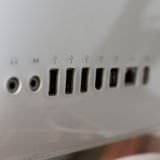FireWire (IEEE 1394) and USB (Universal Serial Bus) are both standards for communication between electronic devices. FireWire is the brand name that Apple uses for the IEEE 1394 interface. It is also known by the brand names of i.LINK (Sony), and Lynx (Texas Instruments). The USB standard has versions 1.0, 2.0 and 3.0 with different devices using different versions.
Comparison chart
History and Development of FireWire vs USB
History of FireWire
FireWire was developed by the IEEE P1394 Working Group, largely driven by contributions from Apple, although major contributions were also made by engineers from Texas Instruments, Sony, Digital Equipment Corporation, IBM, and INMOS/SGS Thomson (now STMicroelectronics).
Apple intended FireWire to be a serial replacement for the parallel SCSI bus while providing connectivity for digital audio and video equipment. Apple's development began in the late 1980s, later presented to the IEEE, and was completed in 1995. On June 12, 2008, all amendments to the standard were incorporated into a superseding standard IEEE Std. 1394-2008.
History of USB
The USB 1.0 specification was introduced in 1996. It was intended to replace the multitude of connectors at the back of PCs, as well as to simplify software configuration of communication devices. USB was created by a core group of companies that consisted of Compaq, Digital, IBM, Intel, Northern Telecom, and Microsoft.
The USB 2.0 specification was released in April 2000 and was standardized by the USB-IF at the end of 2001. Hewlett-Packard, Intel, Alcatel-Lucent, Microsoft, NEC, and Philips jointly led the initiative to develop a higher data transfer rate than the 1.0 specification (480 Mbit/s vs 12 Mbit/s). The USB 3.0 specification was released on November 12, 2008 by the USB 3.0 Promoter Group. Its maximum transfer rate is up to 10 times faster than the USB 2.0 release.
Data transfer speed of USB vs FireWire
Although high-speed USB 2.0 (theoretical speed 400 Mbit/s) nominally runs at a higher signaling rate than FireWire 400 (theoretical speed also 400 Mbit/s), data transfers over S400 FireWire interfaces generally outperform similar transfers over USB 2.0 interfaces. Typical USB PC-hosts rarely exceed sustained transfers of 280 Mbit/s, with 240 Mbit/s being more typical. This is due to USB's reliance on the host-processor to manage low-level USB protocol, whereas FireWire delegates the same tasks to the interface hardware (requiring less or no CPU usage). For example, the FireWire host interface supports memory-mapped devices, which allows high-level protocols to run without loading the host CPU with interrupts and buffer-copy operations.
Besides throughput, other differences are that it uses simpler bus networking, provides more power over the chain, more reliable data transfer, and uses fewer CPU resources.
FireWire 800 is substantially faster than Hi-Speed USB, both in theory and in practice.
USB 3.0 (released November 2008) gives a theoretical speed of 4.8 Gbit/s, which is about 5 times faster than FireWire 800, substantially faster than any of its competitors or predecessors until the next one is released.
Technical Differences between USB and FireWire
USB and FireWire had different design goals when they were first developed. USB was designed for simplicity and low cost, while FireWire was designed for high performance, particularly in time-sensitive applications such as audio and video. USB was originally seen as a complement to FireWire (IEEE 1394), which was designed as a high-speed serial bus which could efficiently interconnect peripherals such as hard disks, audio interfaces, and video equipment. USB originally operated at a far lower data rate and used much simpler hardware, and was suitable for small peripherals such as keyboards and mice.
- USB networks use a tiered-star topology, while FireWire networks use a tree topology.
- USB 1.0, 1.1 and 2.0 use a "speak-when-spoken-to" protocol. Peripherals cannot communicate with the host unless the host specifically requests communication. USB 3.0 is planned to allow for device-initiated communications towards the host (see USB 3.0 below). A FireWire device can communicate with any other node at any time, subject to network conditions.
- A USB network relies on a single host at the top of the tree to control the network. In a FireWire network, any capable node can control the network.
- USB runs with a 5 V power line, while Firewire can supply up to 30 V.
- USB ports can provide up to 500mA of current (2.5 watts of power), while FireWire can in theory supply up to 60 watts of power, although 10 to 20 watts is more typical.
- A FireWire copper cable can be up to 4.5 metres (15 ft) long and is more flexible than most Parallel SCSI cables. The maximum length of a standard USB cable (for USB 2.0 or earlier) is 5.0 metres (16.4 ft). The primary reason for this limit is the maximum allowed round-trip delay of about 1,500 ns.
Cost of USB vs FireWire
The royalty which Apple and other patent holders initially demanded from users of FireWire (US$0.25 per end-user system) and the more expensive hardware needed to implement it (US$1–$2), both of which have since been dropped, have prevented FireWire from displacing USB in low-end mass-market computer peripherals, where product cost is a major constraint.







 USB 2.0
USB 2.0  USB 1.0
USB 1.0  Laptop
Laptop  Mac
Mac  Bluetooth
Bluetooth  Cat6
Cat6
Comments: FireWire vs USB